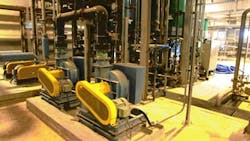Diverse applications rely on blowers to supply gas at relatively low pressure. Process plants usually opt for centrifugal blowers; they use rotating impellers to increase the speed of gas streams. These blowers most often have a single sophisticated three-dimensional impeller — but special blowers sometimes use two or three impellers.
Centrifugal blowers often have variable frequency drives (VFDs) to optimize efficiency as operating conditions change, provide overcurrent protection, reduce power consumption, and facilitate soft startup and shutdown. The most important aspect of VFDs is preventing surge over a wide operating range.
Capacity turndown and delivered head variation are both important features of a centrifugal blower. Speed variation usually serves as the fundamental means of capacity and head control. In many cases, a system of variable inlet guide vanes (VIGVs) also is installed as another way to regulate the blower operation to give the required operational flexibility. Using both methods, a blower can provide a minimum flow as low as 20–30% of the normal flow rate.
Design And Operation
Overhung designs are popular for centrifugal blowers. In some designs that use a gear unit, the impeller is mounted on the gear unit flange. An overhung design offers many benefits such as simplicity and easy access for servicing the diffusor vane assembly or other parts while the casing is off. For safety reasons, a vent valve allows the volute to be purged with inert gas prior to startup.
Figure 1. One blower is operating while the other serves as a standby.
The impeller usually is three-dimensional semi-open (unshrouded) design. Its vanes typically are machined out of a solid forging. Material options include aluminum alloys, stainless steel and alloy steels — and even titanium alloys for some special applications. The impeller is fixed to the shaft by different methods — a popular one is a cylindrical polygon fit, with its unique torque transmission capability. A key-less option generally is preferred.
Spare parts and redundancy are important for critical components such as lubrication oil pumps, oil filters, oil coolers, etc. Storing individual parts of a component in a warehouse is fine but an entire unit, such as a spare lubrication oil pump, should be installed as a standby rather than kept in a warehouse. Sometimes, installing a redundant blower is wise (Figure 1). Standby units require regular monitoring to ensure they will work when needed.
Balancing and spin testing are important for impeller assemblies of high-speed blowers. Each element of the rotating assembly, i.e., impeller, shaft, high-speed gear, etc., should be dynamically balanced to close tolerances. The complete rotating assembly once assembled then should undergo dynamic balancing before installation. Finally, during the mechanical test of the complete unit in the shop, vibration probes should verify lack of vibrations due to unbalance.
For many high-speed blowers (say, above 9,000 rpm), balancing the whole high-speed rotor assembly to ISO 1940 Grade G1 is desirable. However, in some cases, G1 isn’t possible and, for many other cases, assembly balancing to ISO 1940 Grade G2.5 will suffice. Blower impellers usually undergo a spin test in a vacuum chamber at 1.2 times the nominal speed (or 1.15 times the “maximum continuous speed”) together with dimensional checks before and after the test.
Shop performance tests have been specified for many process blowers, with ASME PTC-10 used for many critical units. However, for low-pressure blowers, vendors often propose testing with compressed air in an open loop configuration to reduce the cost of the performance testing. For some of these blowers, such a performance test can’t accord with ASME PTC-10 because air can’t provide aerodynamic similitude. For example, if a large process gas blower must comply with the ASME PTC-10 performance test, using air as the test medium would require the blower to reach 124% of design speed, which may be impossible.
Vibration And Reliability
Radial vibration sensors and monitoring commonly are specified for blowers. X-Y vibration measurement probes for each bearing and a keyphasor transducer for each shaft usually are provided. Sometimes axial probes aren’t specified for low-pressure blowers. This is a major error. While some engineers think axial sensors only are useful for high-pressure applications, this isn’t true. Many mechanical issues and damaging mechanisms, such as misalignment, bent shafts, etc., do create axial vibration. In addition, axial loads and axial vibration (movements) can be affected by machinery process load changes, variation in operating conditions, surge, other operational issues, etc. Axial displacement probes can identify all these very effectively. Moreover, axial vibration measurement will help avoid or predict issues with the thrust (axial) bearing/collar (or similar device), which often is a vulnerable part in such a machine and the cause of many difficulties and failures. High axial vibration also can result in seal problems. Protecting both the thrust bearing and seal requires axial displacement probes. This is particularly true for any blower above 250 kW or in a critical process service.
In some blower applications, uncertainties in suction/discharge conditions and operating situations exist; in those services, axial vibration movement/probes are a good tool to help mitigate these uncertainties and achieve long-term safety and reliability.
Seals
In a process blower, a shaft seal usually is installed to separate the process side from the lubrication oil system. Dry gas seals generally aren’t employed because pressures aren’t high enough. Instead, carbon-ring seals and labyrinth seals commonly are specified and supplied for low-pressure blower applications. The simplest choice is a buffered labyrinth seal; it often is used for air or non-process blower applications. A common option for process blowers is a buffered carbon-ring seal (most often with nitrogen as the buffer gas). Depending on application, a backup seal (usually an additional labyrinth seal) may be provided.
A combined carbon-ring and labyrinth seal is a good choice for blowers. It consists of a dual carbon-ring seal for normal use together with backup labyrinth seals; this limits the seal gas consumption (usually nitrogen) in case of damaged or worn-out carbon rings. This novel technology combines lowest possible seal-gas consumption with good reliability due to the backup characteristic. The seal gas is injected into an intermediate chamber between the two carbon rings and flows both ways from the injection point. A slight process gas stream leaks from impeller tip through the rear impeller labyrinth into the first chamber behind the impeller where it mixes with one portion of the injected seal gas. This chamber is vented to the blower suction, and as such, relieves the area behind the impeller to near suction pressure. Due to the very small clearance between the carbon-ring seal and the shaft sleeve, the amount of seal gas is about 5 to 6 times smaller than that with a conventional labyrinth seal.
Return Gas Blowers
One well-known application for blowers is to return boil-off gas, generated gas or vapor to large storage facilities while they are being unloaded. The gas or vapor fills the void being created by the leaving liquid, thereby preventing tank collapse or the introduction of air/oxygen into the system. These services require a customized blower that can handle a wide variety of operating conditions at relatively low pressure ratios (say, pressure ratios around or below 2). As rough indication, typical volumetric flow rates could be 1,000–40,000 m3/h, and pressure deltas around 0.5–1.5 bar. Many designs use gear units. However, some modern blowers feature high-speed motors that eliminate the need for a gearbox and maximize efficiency and reliability.
Anti-Surge Valves
The surge phenomenon in blowers (and compressors) can be understood as a complete breakdown and reversal of the flow through the machinery. Every centrifugal blower (or compressor) has its own operating characteristic map and surge limits.
A centrifugal blower should have a fully engineered anti-surge system to prevent the machine from going into surge at startup, shutdown and during low-flow operation. This, as a minimum, should comprise a blower discharge-to-suction bypass loop incorporating an anti-surge-valve actuated by a suitable control system. Review anti-surge system details with great care.
Anti-surge-valve sizing and system design should follow modern engineering practices and well-established rules. For example, some commonly used guidelines suggest keeping the anti-surge-valve flow coefficient, Cv, within the range of around 1.8–2 times the required Cv based on the blower surge flow on the highest blower speed curve (on the blower map). For some specific cases, though, the anti-surge-valve Cv might be as low as 1.75 times the required Cv; don’t go lower than this. Also, ensure the anti-surge piping line is as close as possible to the blower, and minimize pressure loss in the anti-surge loop.
Having an appropriate Cv and meeting valve-size and stroking-speed requirements is only the first part of anti-surge-valve selection. Ensuring the anti-surge valve can perform well in closed-loop control also is important. After all, eliminating the potential for surge and damaging vibration in the blower system normally is a bigger concern. Properly addressing this requires attention to other parameters — noise, trim details, actuation system specifics, and many more.
Coupling the latest technologies in anti-surge-valve and actuator designs with smart positioner technology and good accessory selection usually is key to achieving optimal performance from an anti-surge system.
An Example
Let’s consider the selection of a centrifugal blower for a critical process service with a maximum flow rate of around 28,000 m3/h. Five operating cases with different flow rates and pressures have been identified for this blower. As an indication, the minimum suction pressure is 1.02 bara and the maximum discharge pressure is 1.51 bara. Maximum pressure delta is 0.49 bar. After a thorough optimization, the selected blower speed is 9,100 rpm and the motor power is 570 kW. This is a high-speed blower using a 3,000-rpm induction electric motor and a gear unit with gear ratio slightly more than 3. It has a sophisticated three-dimensional semi-open impeller with a diameter exceeding 500 mm and a tip speed of around 225 m/s. The trip speed is set at 9,900 rpm. This blower has an estimated overall efficiency of 73%. For operational flexibility, it is equipped with pneumatically actuated VIGVs as well as a VFD that can adjust speed from 50–103% of nominal. Using both VIGVs and VFD, the minimum flow achievable is around 8,500 m3/h.
The blower has titling-pad radial bearings and a tapered-end axial bearing of around 100-mm diameter. The shaft seal consists of a nitrogen-buffered carbon-ring seal with a backup labyrinth seal. A barrel-type casing is used; the sizes of the suction nozzle and discharge nozzle are 24 in. and 20 in., respectively.
The main lubrication oil pump is a 3,000-rpm screw pump that is coupled to the gear unit. In addition, an auxiliary lubrication oil pump — an electric-motor-driven pump (again, a 3,000-rpm direct-driven unit) — is provided; it also is used for startup. Each oil pump will supply lubrication oil at 9.9 m3/h with 6 barg discharge pressure; each pump has a power rating of around 5 kW (around 1% of the main electric-motor-driver power rating).
The volume of the lubrication-oil stainless-steel tank is around 850 liters (giving around 5-min. oil-retention time). Two aluminum-alloy air-coolers (one operating and one standby) are provided for the lubrication oil system; duplex oil filters are fabricated from stainless steel. The specified lubrication oil is ISO VG 46.
The anti-surge valve for this blower is 18-in., which was sized using an anti-surge-valve Cv of 1.78 times the required Cv based on the blower surge flow on the highest blower speed curve (on the blower map).




